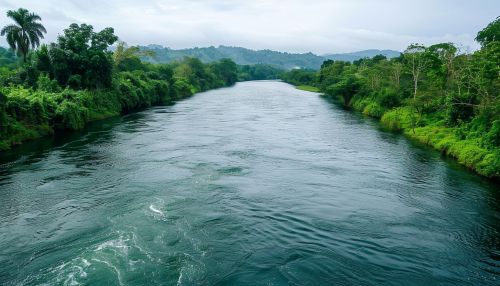Yangtze
Geography
The Yangtze is the longest river in Asia and the third-longest in the world. It originates from the glaciers on the Qinghai-Tibet Plateau in western China and flows eastward across the entire width of China, emptying into the East China Sea at Shanghai. The river is a significant geographical feature, not only for its length but also for the vast basin it drains, covering about one-fifth of the land area of the People's Republic of China.


Hydrology
The Yangtze River's hydrology is complex, with a large number of tributaries contributing to its flow. The river's drainage basin is home to one-third of China's population, making it an essential source of water for agriculture, industry, and domestic use. The river's flow varies seasonally, with the highest water levels occurring during the summer monsoon season. The river's flow is also influenced by the many dams and reservoirs built along its length, including the Three Gorges Dam, the world's largest hydroelectric power station.
Ecology
The Yangtze River basin is rich in biodiversity, supporting a wide variety of plant and animal species. The river is home to several endemic and endangered species, including the Chinese alligator, the Yangtze River dolphin, and the Chinese paddlefish. However, the river's ecology has been significantly affected by human activities, including pollution, overfishing, and habitat destruction caused by dam construction and urban development.
History
The Yangtze River has played a crucial role in the history and development of China. The river basin is considered one of the cradles of Chinese civilization, with archaeological evidence of human activity dating back thousands of years. The river has been a vital transportation and trade route throughout China's history, and many significant historical events, including wars and revolutions, have taken place along its banks.
Economy
The Yangtze River is a major economic artery for China, supporting a significant portion of the country's economic activity. The river is a vital transportation route, carrying goods and people across the country. The river basin is a major agricultural area, producing a significant portion of China's food. The river is also a major source of hydroelectric power, with numerous dams and power stations along its length.
Culture
The Yangtze River has a profound influence on Chinese culture. The river and its surrounding landscape have inspired countless works of literature, art, and music. The river is also central to many local and regional cultural traditions, including festivals, religious practices, and culinary traditions.
Challenges
Despite its importance, the Yangtze River faces a number of environmental and social challenges. These include pollution, overfishing, habitat destruction, and the displacement of local communities due to dam construction and urban development. Addressing these challenges is a major focus of both government policy and non-governmental conservation efforts.
